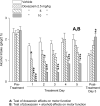The α1-adrenergic receptor antagonist, doxazosin, reduces alcohol drinking in alcohol-preferring (P) Rats
- PMID: 22758213
- PMCID: PMC3470781
- DOI: 10.1111/j.1530-0277.2012.01884.x
The α1-adrenergic receptor antagonist, doxazosin, reduces alcohol drinking in alcohol-preferring (P) Rats
Abstract
Background: Evidence supports a role for the noradrenergic system in alcohol drinking in animals and humans. Our previous studies demonstrated the efficacy of prazosin, an α1-adrenergic antagonist, in decreasing alcohol drinking in rat models of alcohol dependence. Prazosin has also been shown to decrease alcohol drinking in treatment-seeking alcohol-dependent men. Clinically, the use of prazosin is limited by the requirement for multiple daily administrations, whereas doxazosin, a structurally similar α1-adrenergic antagonist, requires only once-daily dosing. In this study, we tested the hypothesis that doxazosin, like prazosin, would decrease alcohol drinking in rats selectively bred for alcohol preference (P line).
Methods: Adult male P rats were given 2 h/d scheduled access to a 2-bottle choice (15% v/v alcohol vs. water) session 5 d/wk (M-F), with food and water available ad libitum 24 h/d. Rats were injected with doxazosin (0 to 10 mg/kg, IP) 40 minutes prior to initiation of the alcohol access session in 3 trials (of 3, 5, and 5 consecutive days) each separated by 5 to 8 weeks. The third trial included 1 day without alcohol access (for locomotor testing), and 1 day of a single hour of alcohol access (for plasma alcohol determination).
Results: Doxazosin significantly reduced alcohol intake in all 3 trials. The 5 mg/kg dose consistently reduced alcohol intake, increased water drinking, did not affect locomotor activity, and resulted in lower plasma alcohol concentrations, suggesting that the doxazosin-induced reduction in alcohol drinking was not dependent on a motor impairment or an alteration in alcohol clearance.
Conclusions: Doxazosin decreases voluntary alcohol consumption by male alcohol-preferring (P) rats, supporting a role for the noradrenergic system in alcohol drinking in P rats and suggesting that doxazosin could potentially be an effective once-daily pharmacotherapeutic agent for the treatment of alcohol use disorders.
Copyright © 2012 by the Research Society on Alcoholism.
Figures








Similar articles
-
Combining the α1 -adrenergic receptor antagonist, prazosin, with the β-adrenergic receptor antagonist, propranolol, reduces alcohol drinking more effectively than either drug alone.Alcohol Clin Exp Res. 2014 Jun;38(6):1532-9. doi: 10.1111/acer.12441. Epub 2014 May 30. Alcohol Clin Exp Res. 2014. PMID: 24891220 Free PMC article.
-
The alpha1-adrenergic receptor antagonist, prazosin, reduces alcohol drinking in alcohol-preferring (P) rats.Alcohol Clin Exp Res. 2009 Feb;33(2):264-72. doi: 10.1111/j.1530-0277.2008.00829.x. Epub 2008 Nov 19. Alcohol Clin Exp Res. 2009. PMID: 19032582 Free PMC article.
-
The α2-adrenergic receptor agonist, clonidine, reduces alcohol drinking in alcohol-preferring (P) rats.Alcohol. 2014 Sep;48(6):543-9. doi: 10.1016/j.alcohol.2014.07.002. Epub 2014 Jul 14. Alcohol. 2014. PMID: 25085719 Free PMC article.
-
Scheduled access alcohol drinking by alcohol-preferring (P) and high-alcohol-drinking (HAD) rats: modeling adolescent and adult binge-like drinking.Alcohol. 2014 May;48(3):225-34. doi: 10.1016/j.alcohol.2013.10.004. Epub 2013 Oct 31. Alcohol. 2014. PMID: 24290311 Free PMC article. Review.
-
Doxazosin. A review of its pharmacodynamic and pharmacokinetic properties, and therapeutic efficacy in mild or moderate hypertension.Drugs. 1988 May;35(5):525-41. doi: 10.2165/00003495-198835050-00003. Drugs. 1988. PMID: 2899495 Review.
Cited by
-
Effects of idazoxan on alcohol pharmacokinetics and intoxication: a preliminary human laboratory study.Alcohol Clin Exp Res. 2015 Apr;39(4):594-602. doi: 10.1111/acer.12658. Alcohol Clin Exp Res. 2015. PMID: 25833022 Free PMC article. Clinical Trial.
-
Doxazosin for the treatment of co-occurring PTSD and alcohol use disorder: Design and methodology of a randomized controlled trial in military veterans.Contemp Clin Trials. 2018 Oct;73:8-15. doi: 10.1016/j.cct.2018.08.009. Epub 2018 Aug 24. Contemp Clin Trials. 2018. PMID: 30145268 Free PMC article.
-
GHSR blockade, but not reduction of peripherally circulating ghrelin via β1-adrenergic receptor antagonism, decreases binge-like alcohol drinking in mice.Mol Psychiatry. 2025 Mar;30(3):1047-1056. doi: 10.1038/s41380-024-02713-3. Epub 2024 Sep 5. Mol Psychiatry. 2025. PMID: 39232198 Free PMC article.
-
Combining the α1 -adrenergic receptor antagonist, prazosin, with the β-adrenergic receptor antagonist, propranolol, reduces alcohol drinking more effectively than either drug alone.Alcohol Clin Exp Res. 2014 Jun;38(6):1532-9. doi: 10.1111/acer.12441. Epub 2014 May 30. Alcohol Clin Exp Res. 2014. PMID: 24891220 Free PMC article.
-
Intravenous Ethanol Administration and Operant Self-Administration Alter Extracellular Norepinephrine Concentration in the Mesocorticolimbic Systems of Male Long Evans Rats.Alcohol Clin Exp Res. 2020 Aug;44(8):1529-1539. doi: 10.1111/acer.14397. Epub 2020 Jul 20. Alcohol Clin Exp Res. 2020. PMID: 32573991 Free PMC article.
References
-
- Abercrombie E, Keller R. Characterization of hippocampal norepinephrine release as measured by microdialysis perfusion: pharmacological and behavioral studies. Neuroscience. 1988;27:897–904. - PubMed
-
- Amit Z, Brown ZW, Levitan DE, Ogren SO. Noradrenergic mediation of the positive reinforcing properties of ethanol: I. Suppression of ethanol consumption in laboratory rats following dopamine-beta-hydroxylase inhibition. Arch Int Pharmacodyn Ther. 1977;230:65–75. - PubMed
-
- Babamoto KS, Hirokawa WT. Doxazosin: a new alpha 1-adrenergic antagonist. Clin Pharm. 1992;11:415–427. - PubMed
-
- Begleiter H, Porjesz B. What is inherited in the predisposition toward alcoholism? A proposed model. Alcohol Clin Exp Res. 1999;23:1125–1135. - PubMed
Publication types
MeSH terms
Substances
Grants and funding
LinkOut - more resources
Full Text Sources
Medical

